不同血液净化方式对维持性血液透析患者残余肾功能的影响
不同血液净化方式对维持性血液透析患者生活质量的影响

不同血液净化方式对维持性血液透析患者生活质量的影响作者:何帆马丽杨文君来源:《现代养生·下半月》2018年第09期【摘要】目的:对于不同的血液净化方式对维持性血液透析患者生活质量的影响进行评价,以便于为临床的干预工作提供有价值的参考依据。
方法:本研究采用分组对照方法进行调查研究所有的研究对象为我院在2017年1月到2018年3月期间所收治的来我院进行血液透析治疗的患者,本研究为方便调查研究选择其中的8 6例患者作为研究对象,将所有患者随机分为观察组与对照组,每组患者平均为43例。
本研究对照组患者选择采用血液透析进行治疗,为患者每周进行为期三次的血液透析治疗,每次血液透析需要持续四个小时,而观察组患者则选择采用杂合型血液透析方法进行血液透析治疗,为患者每周进行血液透析两次治疗,患者需要加血液滤过一次,或者为患者进行血液滤过透析加灌注一次,对于两组患者的生活质量进行评价,并作比较。
结果:评价本研究两组患者不同方式血液净化前后患者的生活质量,并且进行比较,两组患者在进行血液透析以前,生活质量方面没有明显的差异性,P>0.05,差异不具有统计学意义;血液透析结束之后对于两组患者的生活质量情况进行评价,P【关键词】血液净化;维持性血液透析;生活质量临床有一些病症在进行治疗过程当中,需要为患者进行维持性血液透析,比如说终末期肾衰竭患者[l]。
临床有研究认为全世界超过80%以上的晚期肾脏衰竭患者,都需要通过血液透析来维持患者的生命,长时间为患者进行血液透析,这种方法虽然能帮助患者在一定程度上改善个人的状况,但是不能够从根本上对于全部肾脏功能进行替代[2]。
而且血液透析本身会导致患者存在有皮肤搔痒、营养不良等多种并发症情况,对于患者的生活质量也会产生一系列的影响。
因此对于不同的血液净化方式进行分析,研究有效的能够提升患者生活质量的血液透析方案是十分重要的,本研究针对于此进行调查和研究,分析不同方式的血液净化对于维持性血液透析患者生活质量的影响,并且将主要的研究情况作出如下的报告。
不同血液净化方式对维持性血液透析患者的影响研究及效果分析

不同血液净化方式对维持性血液透析患者的影响研究及效果分析目的:分析不同血液凈化方式对维持性血液透析(MHD)患者的微炎症、营养状态和生活质量的影响。
方法:选取2012年10月-2017年6月来本院接受血液净化治疗的尿毒症患者100例作为研究对象,按照不同的治疗方式将其分为血液透析(HD)组(n=30)、血液透析滤过(HDF)组(n=35)和血液透析(HD)+血液灌流(HP)组(n=35),分析不同血液净化方式对维持性血液透析患者的影响。
结果:治疗后HDF组及HD+HP组的微炎症和营养状态指标水平与治疗前比较均明显改善,其中Hb及ALB均明显升高,IL-6、CRP和β2-微球蛋白均明显降低,差异均有统计学意义(P<0.05);HD组与治疗前比较上述指标均无明显变化,差异均无统计学意义(P>0.05)。
治疗后,HDF组及HD+HP组的微炎症和营养状态指标水平与HD组比较均明显改善,差异均有统计学意义(P<0.05);但HDF组和HD+HP组比较,差异均无统计学意义(P>0.05)。
治疗后,HDF组和HD+HP组患者的各项生活质量评分与治疗前比较均有所提升,差异均有统计学意义(P<0.05);但HD组与治疗前比较,差异均无统计学意义(P>0.05)。
治疗后HDF组及HD+HP组各项生活质量评分均明显高于HD组,差异均有统计学意义(P<0.05);而HD+HP组和HDF组间比较,差异均无统计学意义(P>0.05)。
结论:维持性血液透析患者存在微炎症状态,开展HDF以及HD+HP 治疗,可起到一定改善效果,有助于患者疾病转归,提升生活品质,值得进一步推广。
血液净化为治疗晚期肾脏衰竭患者的有效方式,使用此法进行治疗,能全面延长尿毒症患者的生命质量。
但值得说明的是,和健康人群相比,接受血液透析(Hemodialysis,HD)的患者出现并发症的概率以及病死率明显较高。
有文献指出,接受血液透析治疗患者存在微炎症状态,在这种情况下发生并发症的概率明显较高[1]。
不同血液净化方式对维持性血液透析患者残余肾功能的影响分析
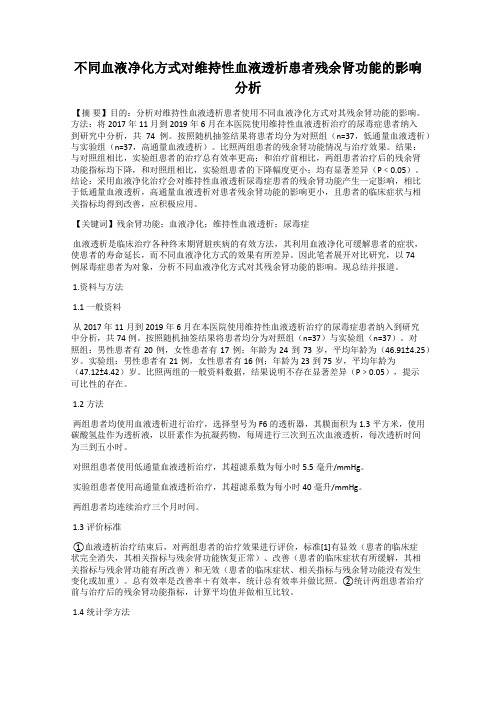
不同血液净化方式对维持性血液透析患者残余肾功能的影响分析【摘要】目的:分析对维持性血液透析患者使用不同血液净化方式对其残余肾功能的影响。
方法:将2017年11月到2019年6月在本医院使用维持性血液透析治疗的尿毒症患者纳入到研究中分析,共74例。
按照随机抽签结果将患者均分为对照组(n=37,低通量血液透析)与实验组(n=37,高通量血液透析)。
比照两组患者的残余肾功能情况与治疗效果。
结果:与对照组相比,实验组患者的治疗总有效率更高;和治疗前相比,两组患者治疗后的残余肾功能指标均下降,和对照组相比,实验组患者的下降幅度更小;均有显著差异(P﹤0.05)。
结论:采用血液净化治疗会对维持性血液透析尿毒症患者的残余肾功能产生一定影响,相比于低通量血液透析,高通量血液透析对患者残余肾功能的影响更小,且患者的临床症状与相关指标均得到改善,应积极应用。
【关键词】残余肾功能;血液净化;维持性血液透析;尿毒症血液透析是临床治疗各种终末期肾脏疾病的有效方法,其利用血液净化可缓解患者的症状,使患者的寿命延长,而不同血液净化方式的效果有所差异。
因此笔者展开对比研究,以74例尿毒症患者为对象,分析不同血液净化方式对其残余肾功能的影响。
现总结并报道。
1.资料与方法1.1一般资料从2017年11月到2019年6月在本医院使用维持性血液透析治疗的尿毒症患者纳入到研究中分析,共74例。
按照随机抽签结果将患者均分为对照组(n=37)与实验组(n=37)。
对照组:男性患者有20例,女性患者有17例;年龄为24到73岁,平均年龄为(46.91±4.25)岁。
实验组:男性患者有21例,女性患者有16例;年龄为23到75岁,平均年龄为(47.12±4.42)岁。
比照两组的一般资料数据,结果说明不存在显著差异(P﹥0.05),提示可比性的存在。
1.2方法两组患者均使用血液透析进行治疗,选择型号为F6的透析器,其膜面积为1.3平方米,使用碳酸氢盐作为透析液,以肝素作为抗凝药物,每周进行三次到五次血液透析,每次透析时间为三到五小时。
综述不同血液净化方式对中小分子清除影响(完整版)

不同的血液净化方式对中分子毒素清除的影响随着透析器膜材料和透析设备的快速发展,对尿毒症毒素、透析充分性、透析相关并发症认识的深入,血液净化方式也得到了进一步的拓展。
最初对CRF发病机理的研究将尿素、肌酐等小分子溶质作为主要尿毒症毒素,70年代提出“中分子物质”学说,将毒素分为小分子和中分子物质两大类。
近年研究发现,ESRD患者除中分子肽类外,一些低分子量、甚至较大分子量的蛋白质也因清除或代谢障碍发生量或质的变化,这些变化能导致各种与尿毒症相关的病理生理改变。
目前通常将尿毒症毒素分为三大类:小分子水溶性毒素、中大分子类毒素和与蛋白质结合的毒素。
并认为中大分子毒素(如AGEs、β2-M、PTH等)与尿毒症患者的症状及一些透析远期并发症如心血管疾病(CVD)、β2微球蛋白相关淀粉样变(β2-MG-A)、感染、营养不良、肾性骨病等有关。
晚期糖化终末产物是体内多种蛋白质的氨基酸、脂质和脂蛋白经非酶促糖基化反应产生的终末产物。
不同的透析方式对毒素的清除不同,常规的低通量透析不能有效清除中,大分子毒素1,而血液透析滤过和高通量透析对中分子毒素的清除效果报道不一,本文就不同的透析方式(血液透析滤过、高通量透析和普通血液透析)对中分子毒素的清除效果做一综述。
糖化终末产物AGEs是在非酶促条件下,蛋白质、氨基酸、脂类或核酸等大分子物质的游离氨基与还原糖的醛基经过缩合、重排、裂解、氧化修饰后产生一组稳定的终末产物。
该反应早在1912年就被法国化学家Maillard发现,故又称Maillard反应。
在反应早期,蛋白质的氨基与还原糖的醛基缩合成一不稳定的Schiff碱,该过程需时很短,而且是一可逆过程;然后由Schiff碱经过环化、异构化重排形成醛胺类产物,即Amadori产物;Amadori产物可以经过氧化、降解、脱水、重排产生醛类(aldehyde)、双碳化合物(dicarbonyl)、还原酮类(reductone)等中间产物,这些中间产物可进一步聚合或再与氨基酸、核酸反应形成AGEs1,2。
不同血液净化方法对慢性肾功能衰竭患者血磷清除的比较
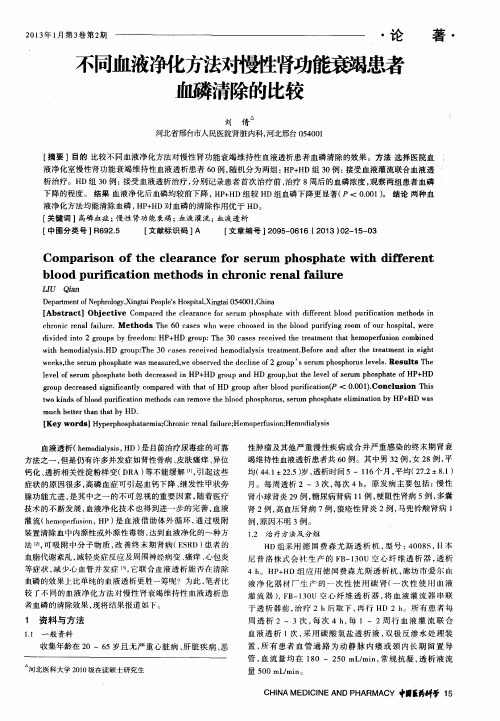
c h r o n i c r e n a l f a i l u r e .M e t hod s T h e 6 0 c a s e s wh o we r e c h o o s e d i n t h e b l o o d p u r i f y i n g r o o m o f o u r h o s p i t a l , We r e
析治疗 。H D组 3 0例 : 接受血 液透析治疗 , 分别 记录患者 首次 治疗前 、 治疗 8周 后的血磷浓度 , 观察两组 患者血磷
下降 的程度 。 结果 血液 净化后血磷均较前 下降 , H P + H D组较 H D组血磷 下降更 显著( P< 0 . 0 0 1 o 结论 两种血
Co mpa r i s o n o f t he c l e a r a nc e f o r s e r u m p ho s ph a t e wi t h d i fe r e n t b l o o d pu r i f i c a t i o n me t ho ds i n c hr o n i c r e n a l f a i l u r e
2 0 1 3 年 1 月 第 3 卷 第 2 期
不同血液净化模式对终末期肾病患者的自身免疫、炎症应激及生活质
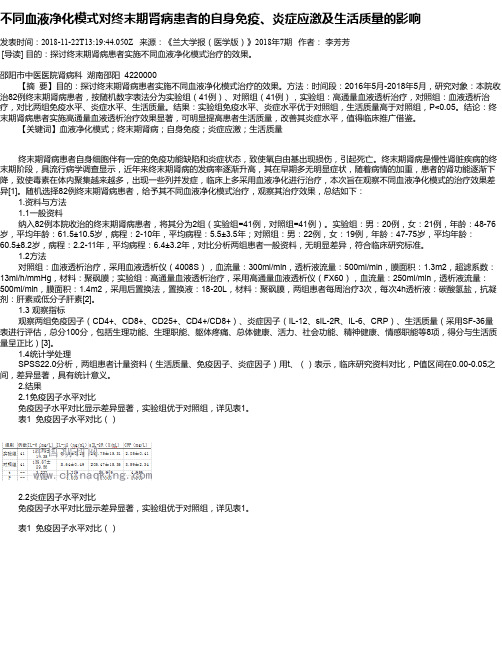
不同血液净化模式对终末期肾病患者的自身免疫、炎症应激及生活质量的影响发表时间:2018-11-22T13:19:44.050Z 来源:《兰大学报(医学版)》2018年7期作者:李芳芳[导读] 目的:探讨终末期肾病患者实施不同血液净化模式治疗的效果。
邵阳市中医医院肾病科湖南邵阳 4220000【摘要】目的:探讨终末期肾病患者实施不同血液净化模式治疗的效果。
方法:时间段:2016年5月-2018年5月,研究对象:本院收治82例终末期肾病患者,按随机数字表法分为实验组(41例)、对照组(41例),实验组:高通量血液透析治疗,对照组:血液透析治疗,对比两组免疫水平、炎症水平、生活质量。
结果:实验组免疫水平、炎症水平优于对照组,生活质量高于对照组,P<0.05。
结论:终末期肾病患者实施高通量血液透析治疗效果显著,可明显提高患者生活质量,改善其炎症水平,值得临床推广借鉴。
【关键词】血液净化模式;终末期肾病;自身免疫;炎症应激;生活质量终末期肾病患者自身细胞伴有一定的免疫功能缺陷和炎症状态,致使氧自由基出现损伤,引起死亡。
终末期肾病是慢性肾脏疾病的终末期阶段,具流行病学调查显示,近年来终末期肾病的发病率逐渐升高,其在早期多无明显症状,随着病情的加重,患者的肾功能逐渐下降,致使毒素在体内聚集越来越多,出现一些列并发症,临床上多采用血液净化进行治疗,本次旨在观察不同血液净化模式的治疗效果差异[1]。
随机选择82例终末期肾病患者,给予其不同血液净化模式治疗,观察其治疗效果,总结如下: 1.资料与方法1.1一般资料纳入82例本院收治的终末期肾病患者,将其分为2组(实验组=41例,对照组=41例)。
实验组:男:20例,女:21例,年龄:48-76岁,平均年龄:61.5±10.5岁,病程:2-10年,平均病程:5.5±3.5年;对照组:男:22例,女:19例,年龄:47-75岁,平均年龄:60.5±8.2岁,病程:2.2-11年,平均病程:6.4±3.2年,对比分析两组患者一般资料,无明显差异,符合临床研究标准。
血液透析分别联合血液透析滤过和血液灌流对患者肾性贫血的影响

血液透析分别联合血液透析滤过和血液灌流对患者肾性贫血的影响发布时间:2021-09-01T11:41:42.210Z 来源:《健康世界》2021年12期6月作者:张秀慧[导读] 目的探究血液透析分别联合血液透析滤过和血液灌流对患者肾性贫血的影响。
张秀慧山东威高医疗控股有限公司山东威海 264200摘要:目的探究血液透析分别联合血液透析滤过和血液灌流对患者肾性贫血的影响。
方法:选择2018年8月至2020年4月于我院行维持性血液透析治疗的患者100例,根据简单随机数字法分为A组(血液透析联合血液透析滤过)和B组(血液透析联合血液灌流),各50例。
比较两组治疗前后肾性贫血指标[血红蛋白(Hb)、红细胞压积(Hct)、网织红细胞百分比(Ret)、血清铁]与血钙、血磷、甲状旁腺激素(iPTH)水平,并统计两组不良反应发生率。
结果:治疗后B组Hb、Hct、Ret、血清铁水平均显著高于A组,差异有统计学意义(P<0.05);治疗后B组血钙水平显著高于A组,血磷及iPTH显著低于A组,差异有统计学意义(P<0.05);B组不良反应发生率显著低于A组,差异有统计学意义(P<0.05)。
结论:较血液透析联合血液透析滤过,血液透析联合血液灌流可更加有效纠正患者肾性贫血,降低iPTH水平,改善钙磷代谢。
关键词:血液透析;血液透析滤过;血液灌流;肾性贫血;影响引言贫血是终末期肾脏病(end-stagerenaldisease,ESRD)患者常见并发症之一,一项基于2010—2015年住院患者的全国性调查研究显示,我国成年人慢性肾脏病(chronickidneydiseases,CKD)发病率为10.8%,目前大约有1.2亿CKD患者,维持性血液透析(maintenancehemodialysis,MHD)患者人数以每年11%以上的速度递增。
血液透析已成为世界许多地区终末期肾脏病(ESRD)患者主要的替代疗法,在许多亚洲国家,如菲律宾、日本,80%以上的终末期肾脏疾病患者正在接受这种治疗。
对维持性血液透析患者残余肾功能的观察及护理
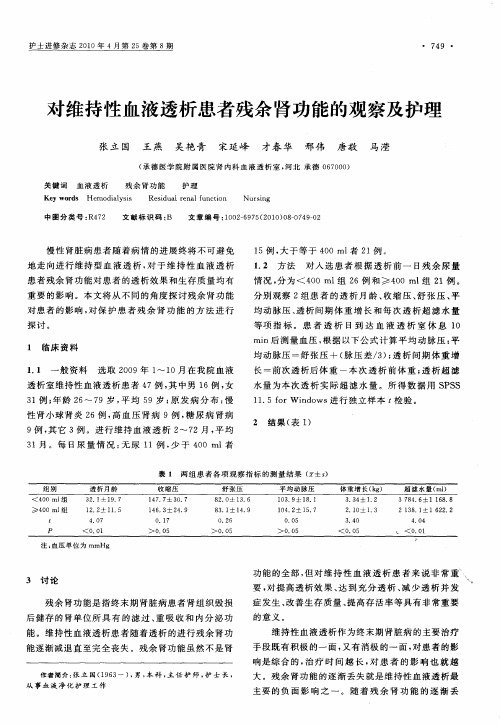
慢 性 肾脏病 患者 随着病 情 的进展 终将不 可 避免 地 走 向进行 维持 型血 液 透 析 ,对 于 维 持性 血 液 透 析 患者残余 肾功能对 患者 的透 析效 果和 生存质 量 均有 重 要 的影 响 。本文 将从 不 同的角度 探讨 残余 肾功 能 对 患者 的影 响 ,对保 护 患者 残 余 肾 功 能 的方 法 进 行 探 讨 。
1 临床 资料
1.1 一般 资料 选 取 2009年 1~10月 在我 院血 液 透 析室维 持性 血液 透析患 者 47例 ,其 中男 16例 ,女 31例 ;年龄 26~79岁 ,平 均 59岁 ;原 发 病 分 布 :慢 性 肾小球 肾炎 26例 ,高血 压 肾病 9例 ,糖 尿 病 肾病 9例 ,其 它 3例 。进 行维 持血 液 透 析 2~72月 ,平均 31月 。每 日尿 量 情 况 :无 尿 ¨ 例 ,少 于 400 ml者
15例 ,大 于等 于 400 ml者 21例 。 1.2 方 法 对入 选 患者 根 据 透 析前 一 日残余 尿 量 情 况 ,分 为 <4oO ml组 26例 和≥ 400 ml组 21例 。 分别 观察 2组 患者 的透 析 月龄 、收缩 压 、舒 张 压 、平 均 动脉压 、透析 间 期体 重 增 长 和每 次 透 析超 滤 水 量 等项 指 标 。 患 者 透 析 日到 达 血 液 透 析 室 休 息 10 min后 测量血 压 ,根据 以下公 式计 算平 均 动脉 压 :平 均动 脉压 一舒 张压 4-(脉 压 差/3);透 析 间期 体 重增 长 一前次 透析后 体 重 一本 次 透 析 前体 重 ;透 析 超 滤 水量 为本 次透 析 实 际超 滤 水量 。所得 数 据 用 SPSS 11.5 for W indows进 行 独 立 样 本 t检 验 。
高通量血液透析对维持性血液透析患者残余肾功能的影响

・56・中国实用医药2019年5月第14卷第14期China Prac Med,May2019,Vol.14,No.14高通量血液透析对维持性血液透析患者残余肾功能的影响李星儒张娜冯新纪晓宁孙灵【摘要】目的探讨髙通量血液透析对维持性血液透析患者残余肾功能的影响。
方法66例维持性血液透析患者,根据随机数字表法分为高通量血液透析组与低通量血液透析组,每组33例。
高通量血液透析组患者采用FX80透析器进行治疗,低通量血液透析组患者采用F7HPS透析器进行治疗,比较两组患者透析前后残余肾功能情况及透析6个月后甘油三酯、胆固醇、血磷、4微球蛋白水平。
结果透析6个月后,两组患者残余肾功能优于透析前,且高通量血液透析组残余肾功能(1.08±0.42)ml/min优于低通量血液透析组的(0.51±0.32)ml/min,差异具有统计学意义(P<0.05)。
透析6个月后,高通量血液透析组患者甘油三酯(0.91±0.54)mmol/L、胆固醇(3.44±0.21)mmol/L.血磷(1.63±0.21)mmol/L、P2微球蛋白(27.53±12.54)ng/ml均低于低通量血液透析组的(1.75±0.36)mmol/L、(4.36士0.25)mmol/L、(1.92±0.31)mmol/L、(35.26±12.37)ng/ml,差异具有统计学意义(P<0.05)。
结论高通量血液透析可降低对维持性血液透析患者残余肾功能损伤,值得推广。
[关键词1髙通量血液透析;维持性血液透析;残余肾功能D0I:10.14163/ki.11-5547/r.2019.14.028血液透析通过将患者体内血液引流至体外,经过弥散等原理进行物质交换,清除体内的代谢废物及过多水分、维持电解质和酸碱平衡,从而替代肾脏排泄作用,延长患者生存时间⑴。
不同血液净化方法对39例维持性血液透析并难治性高血压患者的疗效观察
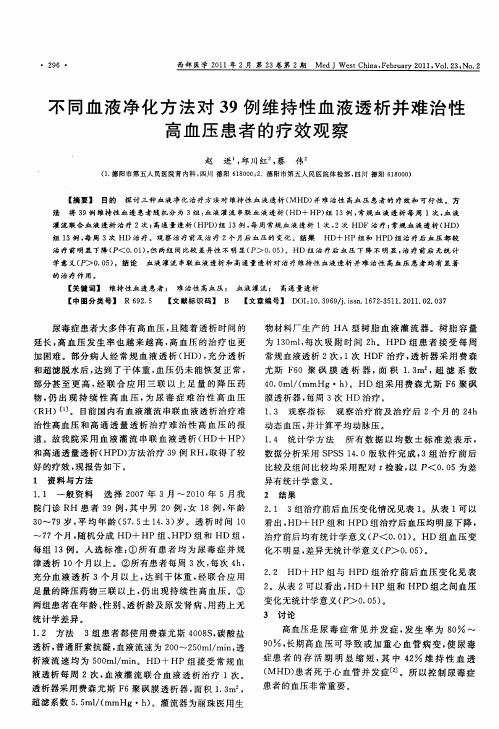
治性 高血压 和高 通 透 量 透 析 治疗 难 治 性 高血 压 的 报 道 。故我 院采 用血 液 灌 流 串联 血 液 透析 ( HD+ HP )
和 高通透量 透析 ( D 方法 治疗 3 例 R 取得 了较 HP ) 9 H, 好 的疗 效 , 现报告如 下 。
堡堂 1 2 第2 卷第2 M d s C i ,er r 21 , o 2 , o2 年 月 3 期 e We h aFbu y 01V 1 3N . J t n a .
不 同血 液 净 化 方 法 对 3 9例 维 持 性 血 液 透 析 并 难 治 性 高 血压 患者 的疗效 观 察
1 资 料 与 方 法
动态血压 , 并计 算平均 动脉压 。 14 统计学 方 法 所 有 数据 以均 数 士标 准 差 表 示 , . 数据 分析采用 S S 4 0版 软 件完 成 , P S1. 3组 治 疗 前 后 比较及 组 间 比较 均采用 配对 t 检验 , P<0 0 以 . 5为 差
7 7个月 , 随机 分成 HD+HP组 、 D组 和 HD组 , HP
每组 1 3例 。入 选标 准 : ①所 有 患 者 均 为 尿 毒症 并 规 律 透析 1 O个 月以上 。②所有 患者 每周 3次 , 每次 4 , h 充 分 血液 透 析 3个 月 以上 , 到干 体重 , 达 经联合 应 用
赵 进 邱 川红 蔡 , , 伟。
( . 阳市 第 五 人 民 医 院 肾 内科 , 1德 四川 德 阳 68 0 ;.德 阳市第 五人 民 医 院体 检 部 , 川 10 0 2 四 1德 阳 6 8 0 ) 1 0 0
不同血液净化方式对维持性血液透析患者残余肾功能的影响比较
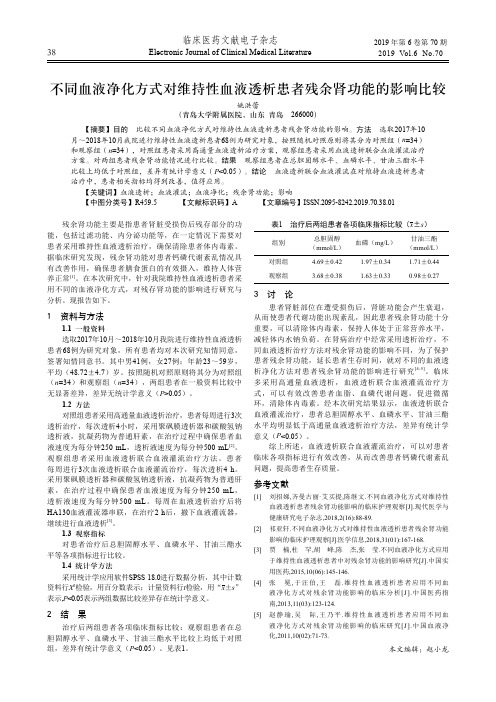
临床医药文献电子杂志Electronic Journal of Clinical Medical Literature 2019 年第 6 卷第 70 期2019 Vol.6 No.7038不同血液净化方式对维持性血液透析患者残余肾功能的影响比较姚洪蕾(青岛大学附属医院,山东青岛 266000)【摘要】目的 比较不同血液净化方式对维持性血液透析患者残余肾功能的影响。
方法 选取2017年10月~2018年10月我院进行维持性血液透析患者68例为研究对象,按照随机对照原则将其分为对照组(n=34)和观察组(n=34),对照组患者采用高通量血液透析治疗方案,观察组患者采用血液透析联合血液灌流治疗方案。
对两组患者残余肾功能情况进行比较。
结果 观察组患者在总胆固醇水平、血磷水平、甘油三酯水平比较上均低于对照组,差异有统计学意义(P<0.05)。
结论 血液透析联合血液灌流在对维持血液透析患者治疗中,患者相关指标均得到改善,值得应用。
【关键词】血液透析;血液灌流;血液净化;残余肾功能;影响【中图分类号】R459.5 【文献标识码】A 【文章编号】ISSN.2095-8242.2019.70.38.01残余肾功能主要是指患者肾脏受损伤后残存部分的功能,包括过滤功能、内分泌功能等,在一定情况下需要对患者采用维持性血液透析治疗,确保清除患者体内毒素。
据临床研究发现,残余肾功能对患者钙磷代谢紊乱情况具有改善作用,确保患者膳食蛋白的有效摄入,维持人体营养正常[1]。
在本次研究中,针对我院维持性血液透析患者采用不同的血液净化方式,对残存肾功能的影响进行研究与分析。
现报告如下。
1 资料与方法1.1 一般资料选取2017年10月~2018年10月我院进行维持性血液透析患者68例为研究对象,所有患者均对本次研究知情同意,签署知情同意书。
其中男41例,女27例;年龄23~59岁,平均(48.72±4.7)岁。
按照随机对照原则将其分为对照组(n=34)和观察组(n=34),两组患者在一般资料比较中无显著差异,差异无统计学意义(P>0.05)。
尿毒清颗粒对维持性血液透析患者残余肾功能和营养状况的影响
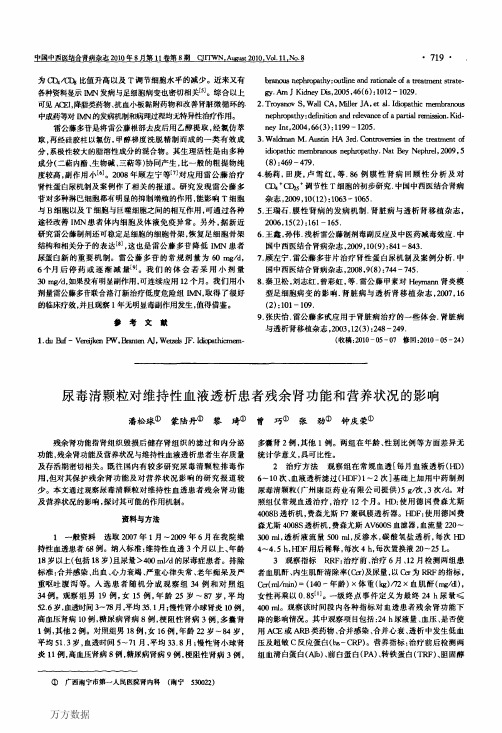
①广西南宁市第一人民医院肾内科(南宁530022)
万方数据
・720・ (TC)、三酰甘油(1、G)、血浆瘦素、肱三头肌处皮褶厚度(TsF)、 上臂肌围(MA^忙)和体重指数(BMI)。 4统计学方法所有数据均用计算机SPSS 13.0统计软 件包处理。连续变量以(j±s)表示。组间比较采用成组t检 裹2两组患者发生终点事件情况 即观察组经过尿毒清颗粒治疗后进人少尿无尿的患者较对照 组少。见表2。 (例)
9.张庆恰.雷公藤多甙应用于肾脏病治疗的一些体会.肾脏病 与透析肾移植杂志,2003,12(3):248—249.
(收稿:2010一05一07修回:2010—05—24)
尿毒清颗粒对维持性血液透析患者残余肾功能和营养状况的影响
潘松球① 蒙陆丹① 黎琦① 曾 巧①
张
劲①钟庆荣①
残余肾功能指肾组织毁损后健存肾组织的滤过和内分泌 功能,残余肾功能及营养状况与维持性血液透析患者生存质量 及存活期密切相关。既往国内有较多研究尿毒清颗粒排毒作 用,但对其保护残余肾功能及对营养状况影响的研究报道较 少。本文通过观察尿毒清颗粒对维持性血透患者残余肾功能 及营养状况的影响,探讨其可能的作用机制。 资料与方法 1一般资料选取2007年1月~2009年6月在我院维 持性血透患者68例。纳入标准:维持性血透3个月以上、年龄 18岁以上(包括18岁)且尿量>400 ml/d的尿毒症患者。排除 标准:合并感染、】出血、心力衰竭、严重心律失常、老年痴呆及严 重呕吐腹泻等。入选患者随机分成观察组34例和对照组 34例。观察组男19例,女15例,年龄25岁~87岁,平均 52.6岁。血透时间3—78月,平均35.1月;慢性肾小球肾炎10例, 高血压肾病10例,糖尿病肾病8例,梗阻性肾病3例。多囊肾 1例,其他2例。对照组男18例,女16例,年龄22岁~84岁。 平均51.3岁,血透时间5~71月,平均33.8月;慢性肾小球肾 炎11例,高血压肾病8例,糖尿病肾病9例,梗阻性肾病3例,
尿毒清颗粒对维持性血液透析患者残余肾功能和营养状况的影响
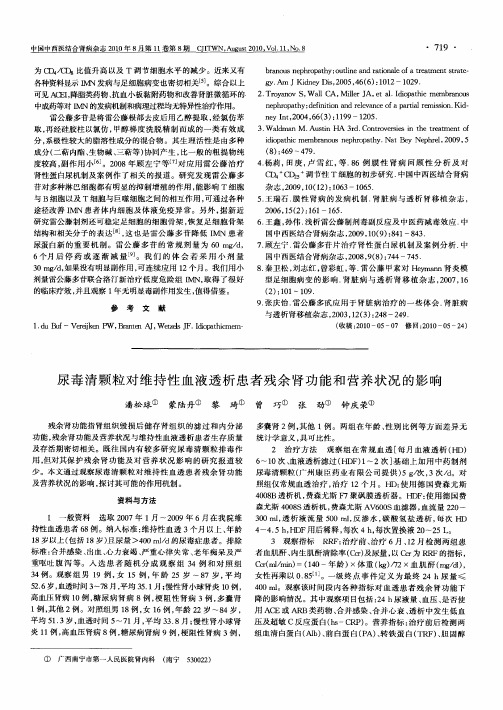
1 d u —V rje Ⅳ, rne J We d F I o ahc e . u B f edk n P B a t A , t sJ .d p t i m n z i m
尿毒 清 颗粒 对 维 持性 血 液 透析 患 者 残余 肾功 能 和 营养 状 况 的影 响
g , m d e i,0 5 4 ( )1 1 YA JKi yDs2 0 ,6 6 :0 2~1 2 . n 0 9
n p r p t y: e i i o d r lv c fap r il e i in. d e h o a h d f t n a ee a eo a t m s o Ki — n i n n ar s
6 个月 后 停 药 或 逐 渐 减 量 _。我 们 的 体 会 若 采 用 小 剂 量 9 j 国 中西 医结 合 肾病 杂 志 ,0 8 9 8 :4 —7 5 2 0 , () 7 4 4 . 3 / , 0mgd 如果没有明显副作用 , 可连续应用 1 2个月。我们用小 8 秦卫松 , . 刘志红 , 曾彩虹 , . 等 雷公 藤 甲素对 Heman肾炎模 y n
Try n v S, 1 A, l rJ e Iip ti mba o s l 1 可见 A E , C I降脂类药物 、 抗血小板黏附药物和改善 肾脏微循环 的 2. o a o W alC Mie A,ta. do ahcme rn u
n yIt2 0 ,6 3 : 19 2 5 e ,0 4 6 ( ) 19 —17.
度较高 , 副作 用小 [ 。2 0 顾左 宁 等【 对应用 雷公 藤 治疗 4杨 莉 , 6 0 8年 j 7 J . 田庚 , 雪 红 , . 6例 膜 性 肾病 回顾 性 分 析 及 对 卢 等 8
不同残余肾功能在维持性血液透析患者营养状况的异同
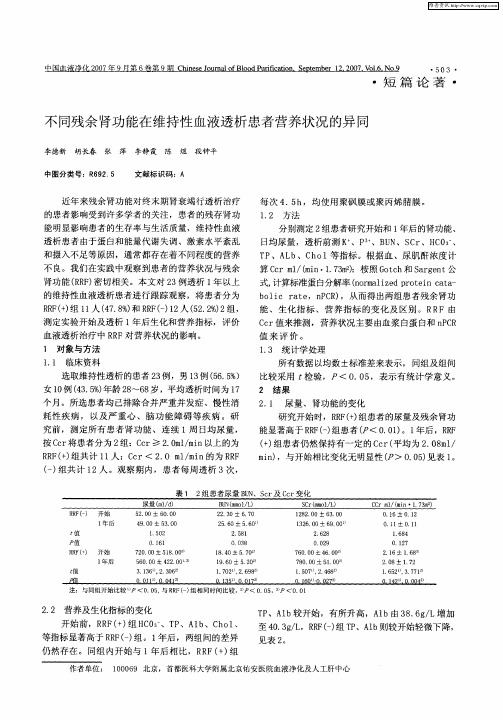
测 定实验 开始及 透析 1年后 生化和 营养 指标 ,评 价 血 液透 析治疗 中 R F对 营养 状况 的影 响 。 R
1 对象 与方 法
1 1 临床 资料 .
C r值来推 测 ,营养状 况主要 由血浆 白蛋 白和 n C c PR
值 来评 价 。
1 3 统 计学处理 .
所 有数据 以均数 ±标 准差来表 示 , 同组及 组 问
透析 患者 由于蛋 白和能量 代谢 失调 、激 素水平 紊乱 和摄 入不足等 原 因,通 常都存 在着 不 同程 度 的营 养
每 次 4 5 ,均 使用 聚砜 膜 或聚 丙烯 腈膜 。 .h
12 方法 .
分别测定 2 患者研究 开始和 1 组 年后 的肾功能 、 日均尿 量 ,透析 前测 K 、P 、B N、S r、H 0一 U C C 、 3
1 年后 ,R F + 组 n C R ( ) P R由开始 的 1 1 g ( g・ .5/k d 升 高到 1 2 g (g・ ) ) . 2 / k d ,而 R F 一 组 则 由 0 8 g R () . 5/
中毒 ,减少 蛋 白质 分解 。本研 究表 明 ,R F( ) R + 组 患者 H O C 。接近 正常标 准 ,而 R F ~ 组 患者 存在 R ()
选 取维持 性透析 的患者 2 例 ,男 1 例 (6 5 ) 3 3 5.% 女 1 例 (3 5 ) 0 4 .% 年龄 2  ̄6 岁 ,平 均透析 时间 为 1 8 8 7 个 月 。所选 患者均 已排 除合并 严重 并发症 、慢 性消 耗 性疾 病 , 以及 严 重 心 、脑 功 能 障碍 等疾 病 。研
比较采 用 t 验 ,尸< 0 0 ,表 示有 统计 学 意义 。 检 .5
不同血液净化方式对肾性骨病相关因素的影响
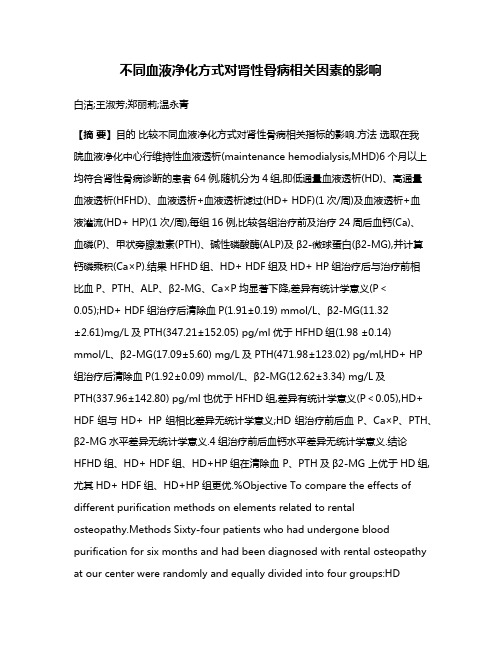
不同血液净化方式对肾性骨病相关因素的影响白洁;王淑芳;郑丽莉;温永青【摘要】目的比较不同血液净化方式对肾性骨病相关指标的影响.方法选取在我院血液净化中心行维持性血液透析(maintenance hemodialysis,MHD)6个月以上均符合肾性骨病诊断的患者64例,随机分为4组,即低通量血液透析(HD)、高通量血液透析(HFHD)、血液透析+血液透析滤过(HD+ HDF)(1次/周)及血液透析+血液灌流(HD+ HP)(1次/周),每组16例,比较各组治疗前及治疗24周后血钙(Ca)、血磷(P)、甲状旁腺激素(PTH)、碱性磷酸酶(ALP)及β2-微球蛋白(β2-MG),并计算钙磷乘积(Ca×P).结果 HFHD组、HD+ HDF组及HD+ HP组治疗后与治疗前相比血P、PTH、ALP、β2-MG、Ca×P均显著下降,差异有统计学意义(P<0.05);HD+ HDF组治疗后清除血P(1.91±0.19) mmol/L、β2-MG(11.32±2.61)mg/L及PTH(347.21±152.05) pg/ml优于HFHD组(1.98 ±0.14)mmol/L、β2-MG(17.09±5.60) mg/L及PTH(471.98±123.02) pg/ml,HD+ HP组治疗后清除血P(1.92±0.09) mmol/L、β2-MG(12.62±3.34) mg/L及PTH(337.96±142.80) pg/ml也优于HFHD组,差异有统计学意义(P<0.05),HD+ HDF组与HD+ HP组相比差异无统计学意义;HD组治疗前后血P、Ca×P、PTH、β2-MG水平差异无统计学意义.4组治疗前后血钙水平差异无统计学意义.结论HFHD组、HD+ HDF组、HD+HP组在清除血 P、PTH及β2-MG 上优于HD组,尤其HD+ HDF组、HD+HP组更优.%Objective To compare the effects of different purification methods on elements related to rental osteopathy.Methods Sixty-four patients who had undergone blood purification for six months and had been diagnosed with rental osteopathy at our center were randomly and equally divided into four groups:HDgroup,HFHD (once a week) group,HD + HDF(once a week) group and HD + HP(once a week) group to compare the changes in the levels ofCa,P,PT H,ALP and β2-MG in each group before treatment and 24 weeks after treatment.Calcium-phosphorus product(Ca × P)was also calculated.Results After treatment,levels of P,ALP,PTH,β2-MG and the product of Ca × P(P <0.05) in the HFHD group HD + HDF group and HD + HP group were significantly decreased.The ability to clean up P(1.91±0.19)mmol/L,β2-MG (11.32 ± 2.61)mg/L and PTH (347.21 ± 152.05)pg/ml in the HD + HDF group was improved compared to P(1.98 ±0.41)mmol/L,β2-MG(17.09 ±5.06) mg/L and PTH(471.98 ± 123.02) pg/ml in the HFHD group.Furthermore,the same ability of the HD + HP group was better than that of the HFHD group(P < 0.05).However,there was no significant difference between HD + HDF group and HD + HPgroup.Meanwhile,the levels of P,Ca × P,PTH and β2-MG in HD group did not decrease after treatment.The level of Ca remained unchanged after treatnent.Conclusions P,PTH and β2-MG in the HFHD group,HD + HDF group and HD + HP group can be better cleaned up than in the HD group.【期刊名称】《武警医学》【年(卷),期】2017(028)006【总页数】4页(P545-548)【关键词】肾性骨病;血液透析;血液灌流;甲状旁腺激素;β2-微球蛋白【作者】白洁;王淑芳;郑丽莉;温永青【作者单位】010010呼和浩特,武警内蒙古总队医院血透室;010010呼和浩特,武警内蒙古总队医院内三科;010010呼和浩特,武警内蒙古总队医院血透室;010010呼和浩特,武警内蒙古总队医院血透室【正文语种】中文【中图分类】R692.5肾性骨病即慢性肾脏病矿物质和骨代谢紊乱(chronic kidney disease-mineral and bone disorder, CKD-MBD),是由慢性肾脏病(chronic kidney disease, CKD)导致矿物质和骨代谢紊乱的综合征,包括Ca、P、甲状旁腺激素(parathyroid hormone,PTH)、维生素D的代谢异常,以及软组织钙化及继发性甲状旁腺功能亢进(secondary hyperparathyroidism,SHPT)[1]。
不同血液净化方式对维持性血液透析患者残余肾功能的影响
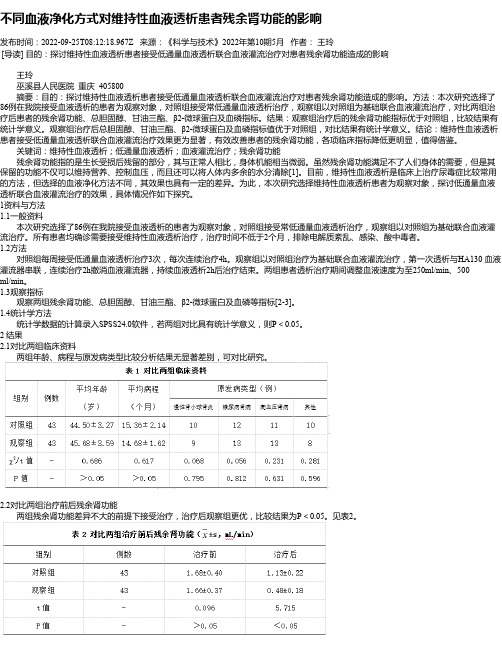
不同血液净化方式对维持性血液透析患者残余肾功能的影响发布时间:2022-09-25T08:12:18.967Z 来源:《科学与技术》2022年第10期5月作者:王玲[导读] 目的:探讨维持性血液透析患者接受低通量血液透析联合血液灌流治疗对患者残余肾功能造成的影响王玲巫溪县人民医院重庆 405800摘要:目的:探讨维持性血液透析患者接受低通量血液透析联合血液灌流治疗对患者残余肾功能造成的影响。
方法:本次研究选择了86例在我院接受血液透析的患者为观察对象,对照组接受常低通量血液透析治疗,观察组以对照组为基础联合血液灌流治疗,对比两组治疗后患者的残余肾功能、总胆固醇、甘油三酯、β2-微球蛋白及血磷指标。
结果:观察组治疗后的残余肾功能指标优于对照组,比较结果有统计学意义。
观察组治疗后总胆固醇、甘油三酯、β2-微球蛋白及血磷指标值优于对照组,对比结果有统计学意义。
结论:维持性血液透析患者接受低通量血液透析联合血液灌流治疗效果更为显著,有效改善患者的残余肾功能,各项临床指标降低更明显,值得借鉴。
关键词:维持性血液透析;低通量血液透析;血液灌流治疗;残余肾功能残余肾功能指的是生长受损后残留的部分,其与正常人相比,身体机能相当微弱。
虽然残余肾功能满足不了人们身体的需要,但是其保留的功能不仅可以维持营养、控制血压,而且还可以将人体内多余的水分清除[1]。
目前,维持性血液透析是临床上治疗尿毒症比较常用的方法,但选择的血液净化方法不同,其效果也具有一定的差异。
为此,本次研究选择维持性血液透析患者为观察对象,探讨低通量血液透析联合血液灌流治疗的效果,具体情况作如下探究。
1资料与方法1.1一般资料本次研究选择了86例在我院接受血液透析的患者为观察对象,对照组接受常低通量血液透析治疗,观察组以对照组为基础联合血液灌流治疗。
所有患者均确诊需要接受维持性血液透析治疗,治疗时间不低于2个月,排除电解质紊乱、感染、酸中毒者。
1.2方法对照组每周接受低通量血液透析治疗3次,每次连续治疗4h。
不同血透方式对尿毒症维持性血液透析患者细胞免疫功能的影响
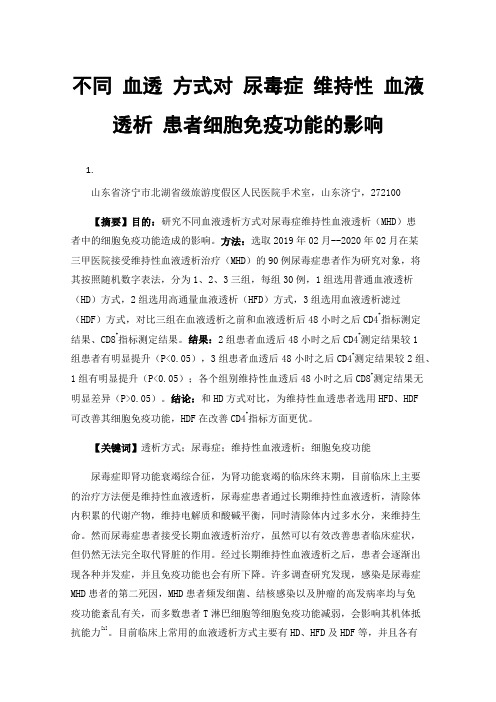
不同血透方式对尿毒症维持性血液透析患者细胞免疫功能的影响1.山东省济宁市北湖省级旅游度假区人民医院手术室,山东济宁,272100【摘要】目的:研究不同血液透析方式对尿毒症维持性血液透析(MHD)患者中的细胞免疫功能造成的影响。
方法:选取2019年02月--2020年02月在某三甲医院接受维持性血液透析治疗(MHD)的90例尿毒症患者作为研究对象,将其按照随机数字表法,分为1、2、3三组,每组30例,1组选用普通血液透析(HD)方式,2组选用高通量血液透析(HFD)方式,3组选用血液透析滤过(HDF)方式,对比三组在血液透析之前和血液透析后48小时之后CD4+指标测定结果、CD8+指标测定结果。
结果:2组患者血透后48小时之后CD4+测定结果较1组患者有明显提升(P<0.05),3组患者血透后48小时之后CD4+测定结果较2组、1组有明显提升(P<0.05);各个组别维持性血透后48小时之后CD8+测定结果无明显差异(P>0.05)。
结论:和HD方式对比,为维持性血透患者选用HFD、HDF可改善其细胞免疫功能,HDF在改善CD4+指标方面更优。
【关键词】透析方式;尿毒症;维持性血液透析;细胞免疫功能尿毒症即肾功能衰竭综合征,为肾功能衰竭的临床终末期,目前临床上主要的治疗方法便是维持性血液透析,尿毒症患者通过长期维持性血液透析,清除体内积累的代谢产物,维持电解质和酸碱平衡,同时清除体内过多水分,来维持生命。
然而尿毒症患者接受长期血液透析治疗,虽然可以有效改善患者临床症状,但仍然无法完全取代肾脏的作用。
经过长期维持性血液透析之后,患者会逐渐出现各种并发症,并且免疫功能也会有所下降。
许多调查研究发现,感染是尿毒症MHD患者的第二死因,MHD患者频发细菌、结核感染以及肿瘤的高发病率均与免疫功能紊乱有关,而多数患者T淋巴细胞等细胞免疫功能减弱,会影响其机体抵抗能力[1]。
目前临床上常用的血液透析方式主要有HD、HFD及HDF等,并且各有优势,但其对患者的细胞免疫功能的如何影响,目前国内外所作研究罕见。
不同血液净化方式对维持性血液透析患者血浆同型半胱氨酸的影响
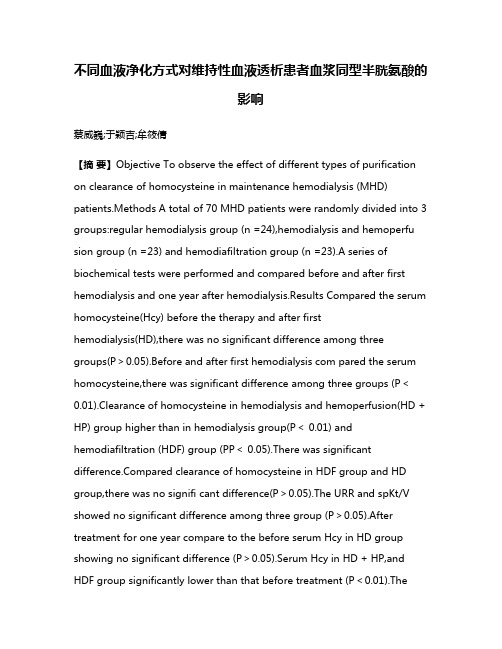
不同血液净化方式对维持性血液透析患者血浆同型半胱氨酸的影响蔡威巍;于颖吉;牟筱倩【摘要】Objective To observe the effect of different types of purification on clearance of homocysteine in maintenance hemodialysis (MHD) patients.Methods A total of 70 MHD patients were randomly divided into 3 groups:regular hemodialysis group (n =24),hemodialysis and hemoperfu sion group (n =23) and hemodiafiltration group (n =23).A series of biochemical tests were performed and compared before and after first hemodialysis and one year after hemodialysis.Results Compared the serum homocysteine(Hcy) before the therapy and after firsthemodialysis(HD),there was no significant difference among three groups(P>0.05).Before and after first hemodialysis com pared the serum homocysteine,there was significant difference among three groups (P<0.01).Clearance of homocysteine in hemodialysis and hemoperfusion(HD + HP) group higher than in hemodialysis group(P< 0.01) and hemodiafiltration (HDF) group (PP< 0.05).There was significant pared clearance of homocysteine in HDF group and HD group,there was no signifi cant difference(P>0.05).The URR and spKt/V showed no significant difference among three group (P>0.05).After treatment for one year compare to the before serum Hcy in HD group showing no significant difference (P>0.05).Serum Hcy in HD + HP,and HDF group significantly lower than that before treatment (P<0.01).Thedrop of Hcy in HD+ HP group and HDF group was significantly higher than in HD group (P<0.05).There was no significant difference between HD + HP group and HDF group (P>0).05).Conclusions Hyperhomocysteinemia is prevalent in MHD patients.Hemodialysis and hemoperfusion,as well as hemodiafiltration significantly increase the clear ance of serum homocysteine.%目的观察不同血液净化方式对维持性血液透析(MHD)患者血浆同型半胱氨酸(Hcy)的清除效果.方法选取上海市第二人民医院肾内科MHD患者70例,按随机数字表法简单随机化分为常规血液透析(HD)组24例、HD联合血液灌流(HP)组23例、血液透析滤过(HDF)组23例.分别于首次透析前后以及治疗1年后透析前采血,检测血浆Hcy浓度、血肌酐(SCr)、尿素氮(BUN),并进行统计分析比较.结果治疗前及首次透析后3组血浆Hcy组间比较,差异无统计学意义(P>0.05);首次透析前后3组血浆Hcy组内比较,差异均有统计学意义(P<0.01).HD+ HP组Hcy清除率高于HD组(P<0.01)及HDF组(P<0.05),差异有统计学意义;HDF组与HD组Hcy清除率比较,差异无统计学意义(P>0.05).3组尿素氮下降率、单室尿素清除分数比较,差异无统计学意义(P>0.05).治疗1年后,HD组血浆Hcy与治疗前比较,差异无统计学意义(P>0.05);HD+ HP组、HDF组血浆Hcy与治疗前比较,差异均有统计学意义(P<0.01).治疗1年后Hcy下降率比较,HD+ HP 组和HDF组明显高于HD组,差异均有统计学意义(P<0.05);HD+ HP组与HDF 组比较,差异无统计学意义(P>0.05).结论 MHD患者普遍存在高同型半胱氨酸血症,HD联合HP治疗及HDF治疗,均可有效降低MHD患者血浆Hcy浓度.【期刊名称】《临床肾脏病杂志》【年(卷),期】2018(018)003【总页数】4页(P168-171)【关键词】同型半胱氨酸;血液透析;血液灌流;血液透析滤过【作者】蔡威巍;于颖吉;牟筱倩【作者单位】200011 上海,上海市第二人民医院肾内科;200011 上海,上海市第二人民医院肾内科;200011 上海,上海市第二人民医院肾内科【正文语种】中文随着血液净化技术的不断发展,终末期肾病(ESRD)患者的生存期逐渐延长。
矿产

矿产资源开发利用方案编写内容要求及审查大纲
矿产资源开发利用方案编写内容要求及《矿产资源开发利用方案》审查大纲一、概述
㈠矿区位置、隶属关系和企业性质。
如为改扩建矿山, 应说明矿山现状、
特点及存在的主要问题。
㈡编制依据
(1简述项目前期工作进展情况及与有关方面对项目的意向性协议情况。
(2 列出开发利用方案编制所依据的主要基础性资料的名称。
如经储量管理部门认定的矿区地质勘探报告、选矿试验报告、加工利用试验报告、工程地质初评资料、矿区水文资料和供水资料等。
对改、扩建矿山应有生产实际资料, 如矿山总平面现状图、矿床开拓系统图、采场现状图和主要采选设备清单等。
二、矿产品需求现状和预测
㈠该矿产在国内需求情况和市场供应情况
1、矿产品现状及加工利用趋向。
2、国内近、远期的需求量及主要销向预测。
㈡产品价格分析
1、国内矿产品价格现状。
2、矿产品价格稳定性及变化趋势。
三、矿产资源概况
㈠矿区总体概况
1、矿区总体规划情况。
2、矿区矿产资源概况。
3、该设计与矿区总体开发的关系。
㈡该设计项目的资源概况
1、矿床地质及构造特征。
2、矿床开采技术条件及水文地质条件。
- 1、下载文档前请自行甄别文档内容的完整性,平台不提供额外的编辑、内容补充、找答案等附加服务。
- 2、"仅部分预览"的文档,不可在线预览部分如存在完整性等问题,可反馈申请退款(可完整预览的文档不适用该条件!)。
- 3、如文档侵犯您的权益,请联系客服反馈,我们会尽快为您处理(人工客服工作时间:9:00-18:30)。
章 茵(攀枝花市第二人民医院内一科,四川 攀枝花 617068)
【摘 要】 目的 比较不同血液净化方式对维持性血液透析患者残余肾功能的影响。 方法 选取进行血液透析的 52 例患者为研究对象,将其随机分为 A 组和 B 组各 26 例,A 组采用低通量血液透析法进行治疗,B 组采用高通量血液透 析法进行治疗,将两组患者透析前及透析后 3、6、9 个月的残余肾功能及 血清磷、三酰甘油、β2 微球蛋白、甲状旁腺激素水 平进行检测及比较。 结果 B 组透析后 3、6、9 个月 的残余肾功能好于 A 组,血清磷、三酰甘油、β2 微球蛋白、甲状旁腺激 素水平均低于 A 组,差异均有统计学意义(P<0.05)。 结论 高通量血液透析较低通量血液透析对维持性血液透析患者残 余肾功能的影响要小,在临床中更为可取。
1 资料与方法
1.1 一 般 资 料 选 取 2008 年 1 月 至 2010 年 10 月 在 本 院 进 行 血液透析的患者 52 例,将其随机分为 A 组和 B 组 各 26 例。A 组 的 26 例 中 , 男 14 例 , 女 12 例 , 年 龄 24~76 岁 , 平 均 (47.9±2.3) 岁 ,病 程 1.5~24.5 个 月 ,平 均 (12.3±2.4)个 月 ;原 发 病 :慢 性 肾 盂 肾炎 10 例,高血压性肾病 8 例,慢性肾小球肾炎 5 例,其他 3 例。 B 组的 26 例中男 15 例,女 11 例,年龄 25~76 岁,平均(48.1±2.2) 岁 ,病 程 1.5~25.0 个 月 ,平 均 (12.1±2.6)个 月 ;原 发 病 :慢 性 肾 盂 肾炎 9 例,高血压性肾病 8 例,慢性肾小球肾炎 5 例,其他 4 例。 两 组 患 者 在 年 龄 、性 别 、病 程 及 原 发 疾 病 等 方 面 比 较 ,P>0.05,差 异无统计学意义,具有可比性。 1.2 方法 A 组 采用 低 通 量 血 液 透 析 法 进 行 治 疗 ,为 低 通 量 聚 醚砜膜血液透析器 ;B 组 采用 高 通 量血 液 透 析 法进 行 治 疗 ,为 高 通量聚醚砜中空纤维膜血液透析器,均由成都欧赛医疗器械有限 公司提供。两组透析器膜面积均为 1.3 m2,每次 4 h,每周 3 次 。后 将两组患者透析前及透析后 3、6、9 个月的残余肾功能及血清磷、 三酰甘油、β2 微球蛋白、甲状旁腺激素水平进行检测及比较。
【Key words】 Hemodialysis; Blood purification; Residual renal function
血液净化是临床中治疗尿毒症的有效方法,但是其对患者的 残余肾功能却有一定的影响,而这种影响对于患者的各个方面的 评估指标均极为不利;因此,找到一种既能起到血液净化目的,又 对患 者 的 残 余 肾 功 能 影 响 较 小 的 血 液 净 化 方 式 非 常 重 要[1]。本 文 就不同血液净化方式对维持性血液透析患者残余肾功能的影响 进行观察,报道如下。
【关键词】 血液透析; 血液净化; 残余肾功能 文章编号: 1009-5519(2012)07-0991-01 中图法分类号: R692.5 文献标识码: A
Influence of differenn residual renal function in patients with maintenance hemodialysis ZHANG Yin(First Department of Internal Medicine, Panzhihua Second People′s Hospital,Panzhihua, Sichuan 617068,China)
【Abstract】 Objective To compare the influence of different blood purification modesin on the residual renal function in the patients with maintenance hemodialysis. Methods 52 patients with hemodialysis were chosen as the research subjects and randomly divided into the group A and B,26 cases in each group. The group A took the low-flux hemodialysis method and the group B took the high-flux hemodialysis method. The residual renal function and serum phosphorus ,triglycerides,β2 microglobulin andparathyroid hormone level of the two groups at pre-dialysis and posthemodialysis 3 ,6,9 months were tested and compared. Results The residual renal function at posthemodialysis 3,6,9 months in the group B was better than that in the group A, and the serum phosphorus,triglycerides,β2-microglobulin and parathyroid hormone levels in the group B were lower than those in the group A,all showing statistical differences between the two groups(P<0.05). Conclusion The high-flux hemodialysis has less influence on the residual renal function than low-flux hemodialysis in the patients with maintenances hemodialysis,and it is more desirable in clinical application.
